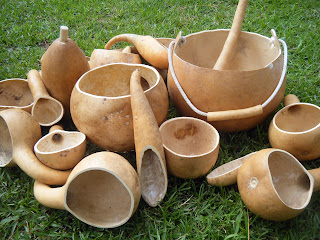Arts and crafts don't get much more homegrown than gourds, picked from a local farmer's field, or grown in your own backyard garden. When I had the opportunity to visit gourd artist and instructor Charlotte Durrence, she told me that archaeological evidence shows gourds have been around for at least 5,000 years.
Durrence notes that Native Americans had long been using gourds for utilitarian items when European settlers first came to the Savannah River area. She says her ancestors at Ebenezer Settlement in 1734 started using gourds just like the local Creek Indians did. Durrence still lives in rural Georgia, in Effingham County.
 "When the wagon trains went out west, I'm guessing that almost every natural spring had a gourd dipper beside it, and everybody drank out of the same thing." Durrence also recalls her own grandmother having a gourd dipper next to the backyard pitcher pump.
"When the wagon trains went out west, I'm guessing that almost every natural spring had a gourd dipper beside it, and everybody drank out of the same thing." Durrence also recalls her own grandmother having a gourd dipper next to the backyard pitcher pump.Bowls, baskets and dippers are part of the historical replica collection that Durrence uses to educate about gourds. She says the most unusual old gourd she's heard of was a tiny one cut to create a lid and used to carry fish bait for someone else's grandfather. "Because of the density of the gourd, it's so much like wood, it kept it cooler, the worms survived much better in that." Gourds have also been used as floats on fishnets.
In recent decades, Americans have commonly used gourd bird houses to attract purple martins, beneficial birds that eat insects and scare away crows from crops. "We do a lot of martin gourds to sell to farmers, they love those kind of things."
 Much of today's artistry creates keepsakes that collectors want to preserve on the shelf. However, gourds have been around so long because of their proven durability and usefulness.
Much of today's artistry creates keepsakes that collectors want to preserve on the shelf. However, gourds have been around so long because of their proven durability and usefulness.Gourd Art Prep & Precautions
